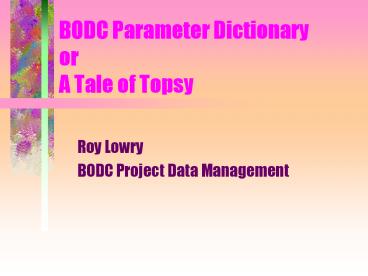BODC Parameter Dictionary or A Tale of Topsy - PowerPoint PPT Presentation
1 / 22
Title:
BODC Parameter Dictionary or A Tale of Topsy
Description:
Once upon a time (in 1987) the organisation MIAS had a parameter dictionary ... Many of these differed from the MIAS dictionary codes ... – PowerPoint PPT presentation
Number of Views:75
Avg rating:3.0/5.0
Title: BODC Parameter Dictionary or A Tale of Topsy
1
BODC Parameter DictionaryorA Tale of Topsy
- Roy Lowry
- BODC Project Data Management
2
The Prologue
- Once upon a time (in 1987) the organisation MIAS
had a parameter dictionary - It covered 129 parameters
- 44 of these were wave statistics
- 31 of these were meteorological parameters
- The rest covered basic hydrography plus various
flavours of sea level
3
The Prologue
- The dictionary was implemented as part of a
Codasyl database - It was maintained through monthly updates by the
DBA - Change was driven by the need to handle different
types of long time series data
4
The Prologue
- The dictionary was based on 8-byte parameter code
which comprised - A 4-byte parameter code
- A 2-byte parameter subgroup
- A 2-byte parameter discriminator
5
The GF3 Era
- As part of the GF3 format development a parameter
code table was developed - This was doomed to failure because the
maintenance overheads (as a printed manual) were
prohibitive - The code table was based on an 8-byte code, four
of which described the parameter
6
GF3 Standardiation
- GF3 provided international standard 4-byte
parameter codes - Many of these differed from the MIAS dictionary
codes - So the MIAS dictionary was updated to bring it
into line with GF3
7
Unexpected Problems
- However, the pre-GF3 codes were in widespread use
- Updating the codes in the data holdings was an
impossible task - Fifteen years on and we still have two different
codes in our data holdings for sea temperature
8
MORAL
- Dont mess around with an operational dictionary
unless it is absolutely ESSENTIAL
9
Project Data Management
- Early projects managed by BODC (North Sea Project
and BOFS) broadened our horizons beyond time
series and CTDs - However, they were supported by databases using
simple non-parameterised data structures
10
Project Data Management
- BOFS exposed the weaknesses of the simple data
structures - Significant work went into database and
associated documentation maintenance - OMEX threatened even more parameter diversity
- A normalised approach was therefore adopted
11
A Dictionary is Born
- A normalised database is based on parameter codes
- Parameter codes need a parameter dictionary
- No suitable dictionaries were available off the
shelf - So, in 1994 I set about building one
12
Design Constraints
- Two dictionaries in one organisation is madness
- The dictionary had to be compatible with the MIAS
dictionary, which meant - Parameter codes had to be 8 bytes (-)
- Codes had to conform to the code/subgroup/discrimi
nator model () - Units linked to first four bytes ()
13
Design Principles
- Systematic code naming is a secondary
consideration (its nice to be consistent but) - Multiple units for a single parameter is avoided
if at all possible (which brings us to..)
14
The Curse of the Kilogram
- All water column parameters in the dictionary are
defined in units of per litre and NOT per
kilogram - Why?
- Measurements are made per litre
- T/S data are not always available
- Consequently fixed factor conversions are used
15
How do We Get Away With it?
- Wherever the T/S data are available an additional
parameter is stored in the database that effects
the per litre to per kilogram conversion - Consequently, we can always deliver per litre,
but can also deliver per kilogram wherever this
is possible
16
Enter Topsy
17
Putting it Another Way
18
How has it Been Done?
- Dictionary maintenance is the responsibility of a
single individual - The science is the important part, not the
hieroglyphics - Great care is taken to ensure that the data are
understood before they are coded
19
Dictionary Implementation
- Implemented as four tables in a relational
database - 8-byte code definitions (ZUSG)
- 4-byte parameter name definitions (ZUPM)
- Parameter category grouping (ZUCT)
- Units definitions (ZUNT)
20
Dictionary Interrogation
- Several tools available within BODC
- ProFortran Search Tool
- Oracle 2000 Form
- Access Forms Interface
- All tools support wildcard searches
21
Dictionary Availability
- The four tables that make up the dictionary are
available by FTP - ASCII (CSV) dumps of the dictionary tables
- Data files are automatically updated every Sunday
(contrast with GF3) - Updates are restricted to BODC areas of interest
22
Conclusion
- A parameter dictionary has been built containing
over 6000 codes - It is successfully underpins the most diverse
oceanographic database in the world - It is freely available to anyone who wants to use
it providing they dont expect BODC to modify it
to their requirements































